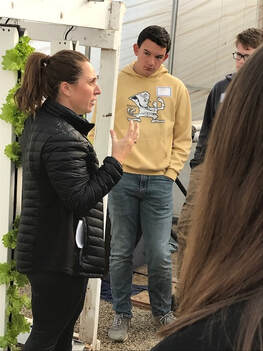
At my service site, Green Bridge Growers, we grow vegetables in two different mediums. One is a traditional in ground planting method and the other is aquaponics in large grow towers. One of the goals of Green Bridge Growers is to train and employ adults with Autism to use their many skills and talents to produce locally grown vegetables. During my service time with Green Bridge Growers I had the opportunity to serve side by side with a number of adults with Autism and help them understand how plants grow, how to treat pest problems and how to harvest many different types of vegetables. One plant that we were able to grow from seed was Kale. We planted the kale seeds and took care of them over several months treating pest problems as they arose and watching for nutritional deficiency, finally we were able to harvest the beautiful kale. We then took the Kale and made a farm to table meal. We did this because many of the adults with Autism have goals they are to work on and learning to eat healthfully, cook and trying new foods are a few of their goals. It was an incredible experience to help them increase their plant knowledge, and increase their understanding of the process of growing their own food from a seed and the hard work and dedication it takes to take a plant from a seed up through harvest. They also increased their life skills by following a task through from beginning to end: walking through the process of harvesting a vegetable and preparing it for a meal with a vegetable they had been unfamiliar with prior to our time together. None of them had ever had the experience of growing something, preparing it and then eating it. It was an amazing experience to watch our core workforce of youth and young adults with autism be so proud of what they had accomplished and see them continue to build on what they’d learned by growing other vegetables and trying new recipes with their harvest.

At my service site, Green Bridge Growers, we grow produce in two ways. The first is the traditional plant in ground method, and the second is growing food in an aquaponics system. With aquaponics, fish and plants grow together. At Green Bridge, we use koi fish as the nutrient source for our plants and we have 7 large tanks of 3600 gallons nutrifying our kale and lettuce. However, in June we began to notice that a few of the koi fish were getting sick. Nate, one of the core staff members at Green Bridge, diagnosed the fish with an issue known as swim bladder disease, which inhibits the fish from swimming correctly. Over the next few weeks we set up a “fish hospital” to treat the sick fish. This required putting the fish in Epsom salt baths for a period of time. After a few weeks the Epsom salt treatments were successful, and we were able to save our fish. At this time Nate was still fairly new to the farm, so it was great to watch him feel more confident in his abilities as he came up with the successful Epsom salt treatments for the fish. I think this was a big turning point in the summer, as it allowed all of us to come together as a team to problem-solve a potentially damaging issue and demonstrated for me the many abilities individuals with autism can contribute in a community setting.

A year ago, I sold my business in the pursuit of turning my passion for horticulture into a career. I had been an avid volunteer at Garfield Park Conservatory for several years, slowly gaining knowledge about plants and beekeeping, and I wanted the opportunity to expand on what I was learning. I moved outside the city to South Bend, Indiana to be closer to the farming communities and learn how to grow my own food.
Several months ago, I was given an opportunity through AmeriCorps to be of service to Green Bridge Growers, a social enterprise dedicated to training and employing young adults on the Autism spectrum using sustainable farming practices. I had originally accepted the role to learn how to farm both traditionally and hydroponically, but what I found after just a few short weeks was that my real sense of joy came from connecting with our core work force members and empowering them to grow along with the plants. I have seen our core workforce members gain confidence, take initiative, improve social skills and take ownership when they may not have done so in the past.
As a result of my service term I have decided to pursue a certificate in Horticulture Therapy and recently applied to a program through the Chicago Botanical Gardens. I hope in the future to be able to continue to support growing both plants and people.
 RSS Feed
RSS Feed
